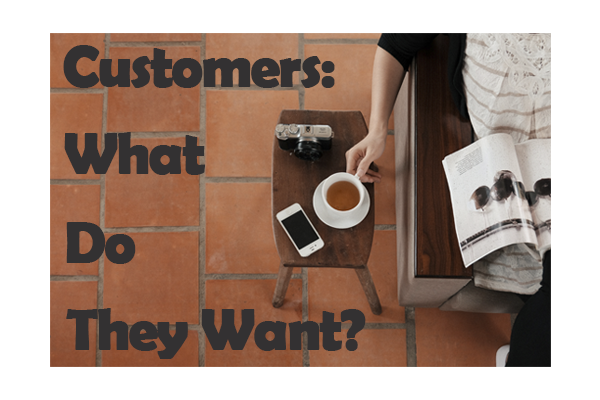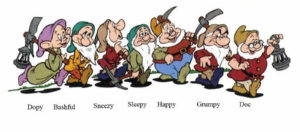
What Do Customers Want?
A survey of 1 million consumers provides valuable insight for today’s marketers.
By Keith Lee
This article was adapted from an article Murray Raphel wrote. You can find out more about Murray and his works at the end of this article.
In the immortal words of Andy Rooney, “Didja ever wonder…..?” Today’s question is whether or not you read those weekly polling reports from The Wall Street Journal, ABC News or the bottom left-hand corner of USA Today and wonder how accurate they are?
If you look at the tiny print at the bottom, most say they are based on interviews with about 1,000 people and have a plus or minus factor of 5 percent. One thousand people? To tell me if we should have a health plan, how the President’s doing, how many diet Cokes are sold in one day, and how many angels fit on the head of a pin? (Only kidding.)
How can that be?
And so I always look askance at the results of this small sampling.
But when I ran across a survey taken by Brit Beemer and America’s Research Group, I sat up, took notice and read everything very, very carefully. What made me sit up? This sentence: ‘The statistics are based on over a million interviews giving valuable insight into consumer behavior and how stores match the needs and values of customers.’
“Whew” — 1 million interviews. Now is the time for all good merchants to come to the aid of their business by knowing what the customer really thinks of your business — well at least one million of them…
Here are some conclusions from the interviews:
“Customers decide if they feel comfortable to buy in your store.”
And: “4 out of 10 customers judge how much you know by how professional you look.”
What does that have to do with your store? What is the first impression your customers get when they walk into your store? What is the first impression they get when you mail them something?
“Most customers know very little about the product you have to sell.”
We recently went shopping for a DVD player. We asked the salesman in the appliance store this question: “This VCR is $89. And this one over here is $149. What’s the difference?” And he said, “fifty dollars.” (now you can’t make that up).
What does that have to do with your store? The old adage of, “the more you tell, the more you sell” works for your business. The more specific you are about what you sell, stressing the benefits you offer, the greater degree of comfort you give your customers. The same is true with your direct mail advertising.
Years ago, Murray Raphel did a mailer to his customers on children’s yellow raincoats that had a place to write the child’s name on the inside collar. Since most children at the time wore yellow raincoats to school they are often mixed up and switched. We emphasized this benefit in a mailing and sold out the coats in three days.
“Most customers say all consumer ads look the same.”
In his advertising class Murray would often place five ads from local supermarkets, with their name cut out, on the board. Each student is given a sheet of paper with the names of the five supermarkets.
“Match up the name of the supermarket with the ad?” Murray asked.
No no one ever got it right!
What does that have to do with your store?
You need to avoid what Dan Kennedy calls Marketing Incest! In almost every industry everyone copies everyone elses advertising so it all looks the same and nothing is effective. Get a Free Trial to Dan Kenndy’s newsletter at www.nobspugetsound.com to find out how to avoid Marketing Incest.
“Customers expect a specialty store to have the largest selection in their chosen product area.”
Many years ago when Murray first started in business, his annual volume was around $20,000 a year. He couldn’t afford to advertise… anywhere. But he knew people would shop with him if he had the biggest selection of… something. He chose children’s hats and gloves because they were so inexpensive. He put hand-lettered signs on his windows: “We have the largest selection of children’s hats and gloves!”
He soon became known as the store to go to for children’s hats and gloves. Not big sales, but once in the store the customer might buy a snowsuit – which was like selling 20 pairs of gloves. They became important, well-known, and business grew.
What does this have to do with your store?
Be a specialist in what you sell. It does not have to be merchandise… it can be service. Murray once asked an elderly woman why she shopped the local pharmacist when the chain store’s prices were lower. Her explanation: “They say hello to me when I come in.”
The customer is reassured when you offer an in-depth selection of any item. It makes them feel you are an expert in that field and gives the perception you are an expert in other areas as well.
When Murray bought clothing in Europe the total inventory was less than 10 percent of what he carried.
He promoted, advertised and talked about the European clothing so much that it became the main emphasis of his inventory. Soon the customer felt everything in the store was imported from Europe.
“Half of America buys with credit, half buys with cash.”
Some of the best and smartest marketers are the credit card companies. First came the cards. Then came the affinity cards. (When you use your credit card you are giving money to your alma mater. Or the humane society. Or building mileage on your favorite airline.) Now there’s co-branding, where the name of your business appears with the name of the credit card.
What does that have to do with your store?
This: The more ways you offer the customer to pay, the higher the return. Offer cash. Or check. Or credit card. Or lay-away. Or monthly payments. Or your own co-branded card. Better: offer them all and then be sure to include the internet.
“A private sale flyer must scream value.”
Retailers have negatively impacted between 25 percent and 40 percent of their core customers by sending false pretense private sale mailers. Many businesses are mailing more often and giving less value.
Here’s what customers see as real value: real lower prices. Deferred credit promotion. Free delivery. Free vacation promotions. Free gifts. First choice at a warehouse or clearance sale.
What does this have to do with your store?
An old and works-every-time adage: “Make sure the story isn’t better than the store.” Another one (Cont. P.6 – What Do Customers) to remember: “Promise a lot. Deliver more.”
If your product has six good selling points, only tell five. Have the sixth featured when the product arrives at the house or is purchased at the store.
This gives the customer even greater confidence that their purchase is even better than “what you advertised.”
Some other guidelines from the survey:
- “The number one reason for buying a big ticket item is No Down Payment.“
- “The number two reason for buying is No Interest.“
- “A very low interest offer will beat out a ‘6-month interest deferred’ offer.”
- “Radio reaches the youngest audience, newspaper the oldest. Radio is the best medium to create a personality for your store.”
- “The word ‘FREE’ in an ad has the greatest impact.”
How much attention should you pay to all this information? A lot. Remember the basic rule in selling is only one sentence: “Find out what the customer wants… and give it to them.”
For more great tips on customer service, go to TheHappyCustomerHandbook.com and get a FREE copy of my book. I reveal 59 secrets to creating happy customers who come back time and time again… AND enthusiastically tell others about you.
Remember, Only Happy Customers Come Back
Keith Lee
Murray Raphel has been telling the retail direct mail story as a columnist in Direct Marketing for more than 30 years. He has developed Gordon’s Alley, a multimillion-dollar pedestrian mall in Atlantic City.
You can reach Murray at Raphel Marketing Inc., 12 S. Virginia Ave., Atlantic City, NJ 08401. His phone number is 609-348-6646.





